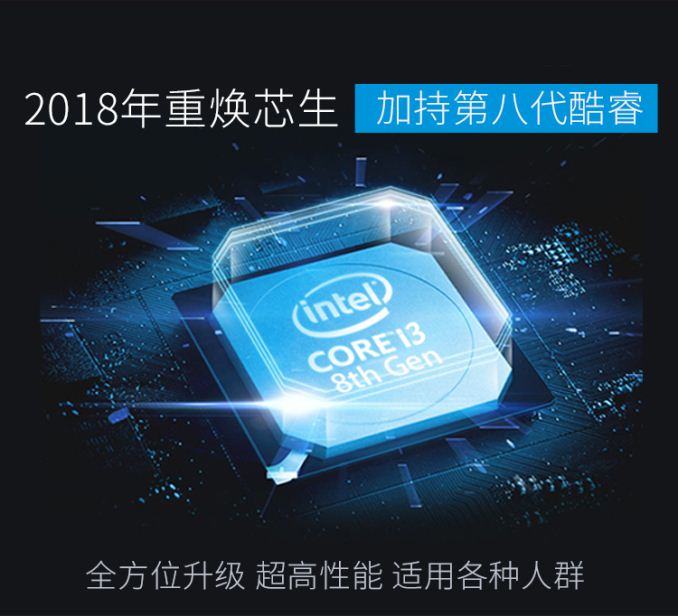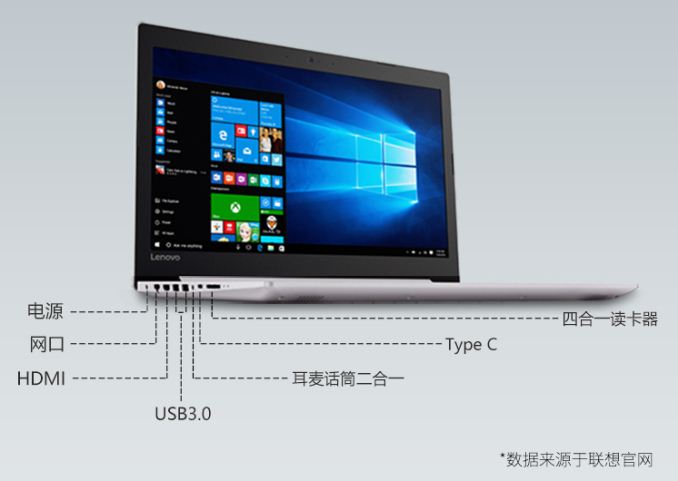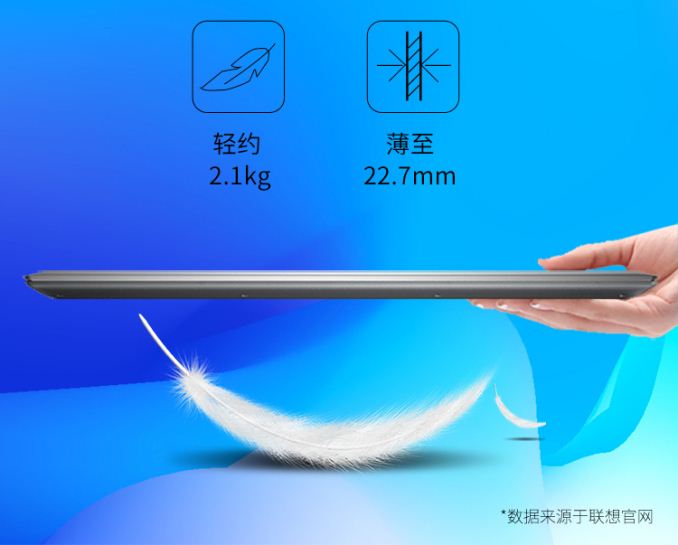First 10nm Cannon Lake Laptop Spotted Online: Lenovo Ideapad 330 for $449
by Ian Cutress on May 13, 2018 11:02 AM EST
In the fruitless efforts to get an answer from Intel as to exactly who is buying their first 10nm processors using the new Cannon Lake microarchitecture, we seem to now have an answer. Lenovo, one of Intel's biggest partners for laptops, has a new Ideapad 330 model available through an official distributor on China's online retailer JD.
The Ideapad 330 is a low end unit in both price and design. The bottom configuration is only 3299CNY, which converts to around $449 pre-tax. This model will feature the new 10nm Core i3-8121, a dual core processor based on Cannon Lake running at a 2.2 GHz base frequency. Pairing with this CPU will be an AMD Radeon RX 540 2GB, as the Intel processor does not have integrated graphics - technically the silicon for them is there, but in this design it is disabled. Our original source, Computerbase.de, states that the processor can turbo up to 3.1 GHz.
The Cannon Lake-based Lenovo Ideapad 330 will be a 15.6-inch laptop, however with a 1366x766 display and a TN panel, both metrics earmarked for low end devices. The stock configuration will be with 4GB of DDR4-2133 memory via a single SO-DIMM module, and a 500GB 5400RPM rotational hard drive for 3299CNY - however the listing on JD.com does offer upgrades up to 8GB of memory, a 1TB spinning drive, and a 256 GB solid state drive, for 3899CNY. The listing does not state which memory configurations are single/dual channel or what brand of storage drives are being used. In actual fact, the images on the listing state DDR4-2133, but the specifications list states DDR4-2400.
The unit will come in at 2.1 kg, and just under an inch thick at 22.7mm. The keyboard offers a full number pad , although it does come with half-height up and down arrow keys. Connectivity on the sides include an expandable gigabit Ethernet port, a HDMI port, two USB 3.0 Type-A ports, a Type-C port (of unknown standard), an SD card reader, a 3.5mm jack, a Kensington lock, and a CD/DVD drive. No metrics for battery life are given, however the retail page puts the component as an upgrade over the Core i3-6006U, Intel's low-end dual core Skylake-U processor for super budget systems.
| Lenovo Ideapad 330 / 10nm Cannon Lake | ||||
| CPU | Intel Core i3-8121U 10nm Cannon Lake Dual Core Four Threads 2.2 GHz Base 3.1 GHz Turbo (?) No Integrated Graphics |
|||
| GPU | AMD Radeon RX 540 2GB | |||
| Display | 15.6-inch 1366x768 TN | |||
| Memory | 4GB, DDR4-2133/2400 1 x SO-DIMM |
8GB, DDR4-2133/2400 ? x SO-DIMM |
||
| Storage | 500 GB HDD or 1TB HDD, 5400 RPM 128GB SSD or 256 GB SSD |
|||
| Dimensions | 378 x 260 x 22.7 mm 2.1 kg |
|||
| Battery | Unknown, listed as '5 hours' on JD.com | |||
| Features | Gigabit Ethernet port 2 x USB 3.0 Type-A 1 x USB ? Type-C 3.5mm jack HDMI output CD/DVD drive |
|||
| Price Low | 4GB DRAM | 500 GB HDD | - | 3299 CNY (~$445) |
| Price High | 8GB DRAM | 1TB HDD | 256 GB SSD | 4299 CNY (~$580) |
| OS | Windows 10 (variant unknown) | |||
This level of system is designed for users that 'just need a system', and is often the choice for businesses that need a mobile platform for their employees. The listing states that this device is for entry level business and student use, although the promotional material does go into the gaming performance of the graphics over other similarly priced solutions.
This machine listed online means that we can confirm that Intel is indeed shipping 10nm components into the consumer market, ending some speculation as to whether Intel was shipping) even though they said they were) and where those components were going. It doesn't solve the question as to how Intel's 10nm process is coming along, especially for the bread and butter of Intel's next generation of processors which should be the backbone of Intel's financials over the next few years. Shipping a low-end dual core processor with disabled graphics doesn't inspire confidence, especially as it is labelled under the 8th gen designation, and not something new and shiny under the 9th gen - although Intel did state in a recent earnings call that serious 10nm volume and revenue is now a 2019 target. These parts are, for better or worse, helping Intel generate some systems with the new technology. We've never before seen Intel commercially use low-end processors to introduce a new manufacturing process, although this might be the norm from now on.
Related Reading
Source: Computerbase.de, JD.com




















84 Comments
View All Comments
Tkan215 - Sunday, May 13, 2018 - link
Made in china brand. Levono want their businessCaedenV - Sunday, May 13, 2018 - link
16" and just over 720p... sounds like a nice HD display to me hahahahahahaLolimaster - Sunday, May 13, 2018 - link
Nothing can compete to Ryzen mobile APU's.Cannon is just a mere die shrink, which was supposed to be the 14nm+++++++++(+). No IPC gains, nothing.
Santoval - Sunday, May 13, 2018 - link
It should be more power efficient though (i.e. consume less power at the same clock or clock higher at the same power). The base clock of this CPU is pretty low, but if it is quite power efficient it will retain its boost clock for a longer time.benedict - Sunday, May 13, 2018 - link
Just because it should be, doesn't mean it actually is.Spunjji - Monday, May 14, 2018 - link
i3 chips don't have boost clocks!bennyg - Tuesday, May 29, 2018 - link
U CPUs do, RTFA, this SKU is base 2.2 turbo 3.1. The issue is how broken 10nm is and whether leakage ruins the theoretical benefit from the shrunken transistors, but the similarity to the 14nm 8130U is not at all encouraging... same 15W power limit + same base + lower turbo despite disabled IGP !!!bennyg - Tuesday, May 29, 2018 - link
correction fwiw, Intel state 8131U turbo up to 3.2 (article report from computerbase.de is wrong) https://ark.intel.com/products/136863/Intel-Core-i...BurntMyBacon - Monday, May 14, 2018 - link
Even if it has great power efficiency, they kill much of the benefit to end users by equipping it with a battery that is only capable of 5hrs operation. Also, i3 processors haven't historically had a boost clock, though I see there is a question about that in the article.CaedenV - Sunday, May 13, 2018 - link
The chip itself will be fine, and an OK step up on power savings and horsepower from 14+++(+)+The real question is how many Intel will sell, and at what cost. 10nm chips are going to be low volume and very expensive to start as they are reportedly having big yield issues. My bet is that we will see a lot of i7 parts with bad cores cut out being sold as i3 and Pentiums at a high price for the next year or so, while the higher end chips will continue being 14nm for a bit yet.
... That or Intel's marketing team will once again decide that i7 on mobile will be even more crap than it already often is (seriously, some of these are Celeron levels of performance!), and sell them for top dollar. Especially now that they are not afraid to sell i9 chips. i3 becomes the new i7, i5 becomes the i9, and i7 becomes the iForever!